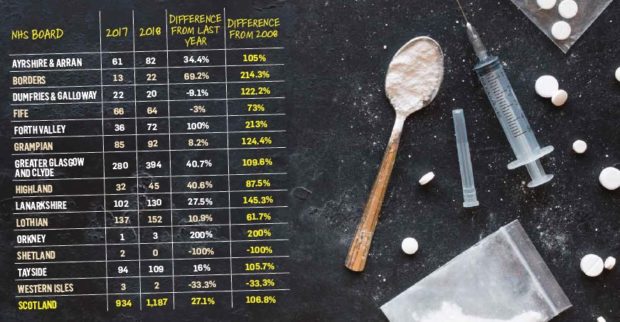Drug deaths in the north and north east reached record levels last year, according to “shocking” new figures, which confirmed the highest-ever number of Scottish fatalities.
Scotland had 1,187 drug-related deaths in 2018, the most ever recorded and a 27% increase on the previous year.
Politicians and doctors have called for an urgent overhaul of drugs policy after it emerged that Scotland’s death rate is nearly triple that of the UK and higher than anywhere else in the EU.
The figures released yesterday by the National Records of Scotland (NRS) represented the first time the annual death toll had breached the 1,000 barrier and was by far the highest since records began in 1996.
Public Health Minister Joe Fitzpatrick said the number of lives lost was “shocking” and added that Scotland was facing a drugs “emergency”.
Mr Fitzpatrick said: “It is vital this tragedy is treated as a public health issue, and we are prepared to take innovative and bold measures to save the lives of those most at risk.”
Mr Fitzpatrick called on the UK Government to introduce “supervised drug consumption facilities” or devolve drugs legislation to Edinburgh, so that Scottish ministers could do so themselves.
Safer Drug Consumption Facilities are places where addicts can inject safely to cut down on deaths and HIV infection.
But the Scottish Conservatives accused the Scottish Government of pinning its hopes on consumption rooms because the UK Government did not agree with them.
Tory public health spokeswomen, Annie Wells, said: “That’s a cowardly approach from those ministers who’re meant to be taking responsibility.”
>> Keep up to date with the latest news with The P&J newsletter
She also criticised the Scottish Government for “parking” addicts on the controversial heroin substitute methadone.
The NRS found that methadone was implicated in 560 Scottish deaths last year, 47% of the total. Heroin and morphine contributed to 45%.
One third of the Scottish deaths took place in the NHS Greater Glasgow health board area where 394 people died as a result of drug use.
NHS Grampian had 92 deaths, which was a 124.4% increase on the 41 fatalities recorded in 2008. NHS Highland experienced a similar trend with deaths increasing by 87.5% from 24 in 2008 to 45 last year.
In the last decade,NHS Grampian and NHS Highland have seen the rate of drugs per 1,000 people increase to their highest level since 2008.
NHS Grampian’s drugs death rate increased from 0.07 in 2008 to 0.16 last year.
During the same period, NHS Highland’s rate rose from 0.08 to 0.14, although both were behind the worst rates found in Glasgow (0.34) and Tayside (0.26) last year.
The use of tranquilisers was identified as a particular problem in the north and north east. Benzodiazepines, which include the drug Xanax, contributed to 51% of Highland deaths and 49% in Grampian last year.
Aberdeen South MP Ross Thomson said: “Ministers must address why the death toll is three times higher here in Scotland than in the rest of the UK, and why it is rising to record levels in areas like the North East and Highlands.
“This is a crisis that requires urgent and radical action.”
Mr Fitzpatrick said his new Drug Deaths Taskforce under Professor Catriona Matheson would tackle the problem.
He added: “I am determined to shape our services in every walk of life to prevent harm and reduce the appalling number of deaths.”
